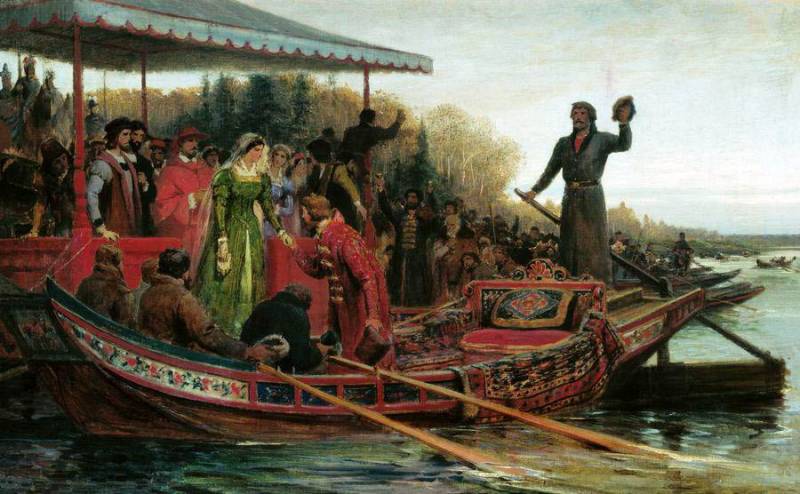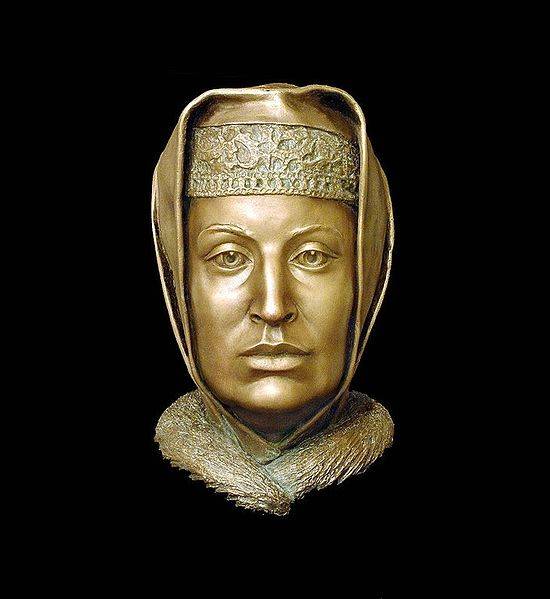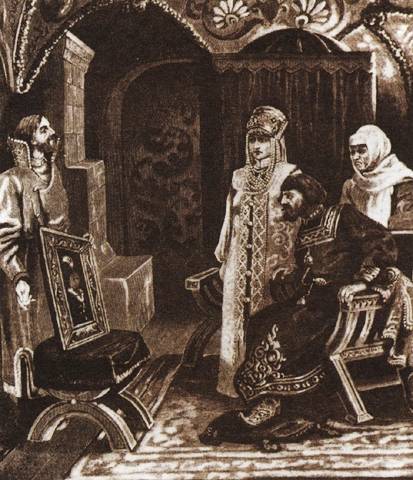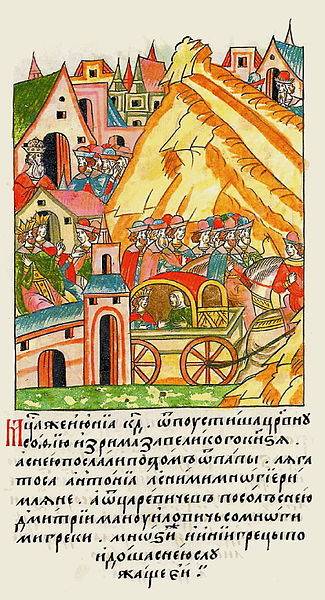"Princess of Tsaregorodskaya" Sophia

Fedor Bronnikov. "Meeting of Princess Sophia Paleolog by Pskov posadniks and boyars on Lake Peipsi"
Byzantine princess
The life path of this woman began around 1450 (the exact date of birth is unknown). Her father, Thomas Palaiologos, was the brother of the last emperor of Byzantium, Constantine XI, and despot of the Morea (Peloponnese). After the fall of Constantinople in 1453 and the death of Emperor Constantine, Thomas fled with his wife and children to the island of Corfu, which then belonged to Venice, then moved to Italy. After the death of his brother, Thomas was recognized by all of Europe as the legitimate emperor of Byzantium. By her mother, Catherine Zaccaria, she belonged to the princely family of Achaia (Principality of the Morea).
Zoya, orphaned early (her parents died in 1465), was brought up with her brothers at the court of the Pope. The guardian of the Palaiologos was a well-known Greek scientist, Cardinal Bessarion of Nicaea, a supporter of the union. This circumstance decided the fate of the once powerful family, but now it has lost its high position, power and wealth. Pontiff Paul II, in order to strengthen the influence of Rome on Rus', proposed that the Moscow sovereign Ivan III, who was widowed in 1469, marry Zoya.
The Russian chronicle reports that in February 1469, the Greek Yuri arrived in Moscow from Cardinal Vissarion to Ivan Vasilyevich with a letter in which Sophia, the daughter of the Morean despot Thomas, an “Orthodox Christian” was offered to the Grand Duke as a bride (her conversion to Catholicism was modestly silent) . The Russian sovereign consulted with his mother, Metropolitan Philip and the Boyar Duma and agreed. It is obvious that the Moscow government liked the idea of marrying the Grand Duke with the “tsarina of Tsaregorodskaya”. True, there was also opposition in Moscow. Many did not like the future marriage of the Grand Duke to a Greek woman, brought up at the court of the head of the Roman Church.
In 1469, a Russian diplomat of Italian origin Ivan Fryazin (Gian Battista della Volpe) was sent to Rome to woo Grand Duke Zoya. Paul II received the ambassador with great honor. The Sofia chronicle testifies that a portrait of the bride was sent back to Rus' with Fryazin: “... and bring the princess on the icon". Negotiations went on for three years. Fryazin went to Rome for the second time in May 1472. On June 1, 1472, an absentee betrothal took place in the Basilica of the Holy Apostles Peter and Paul. Fryazin was the deputy of the Moscow sovereign. On June 24, 1472, a large convoy of Palaiologos, together with Fryazin, left Rome. The bride was accompanied by Cardinal Vissarion. According to legend, a large library was included in Sophia's dowry.

Sofia Paleolog. Plastic reconstruction by S. A. Nikitin, 1994
Princess of Moscow
The convoy of the bride crossed Europe from south to north and on September 1 arrived in the German port of Lübeck. On the way, the honored guest in the cities arranged magnificent receptions and knightly tournaments. The sea voyage across the Baltic Sea lasted 11 days. The caravan arrived in Kolyvan (now Tallinn), in October proceeded through Dorpat (Yuriev), Pskov and Novgorod. On November 12 (21), 1472, Zoya Paleolog entered Moscow. On the same day, her wedding ceremony with Grand Duke Ivan III took place.
At the final stage there was a scandal. The papal representative Antonio Bonubre wanted to enter Moscow carrying a Latin cross (the so-called Korsun cross) in front of him. Metropolitan Philip made a fuss. As a result, the sovereign's envoy, the boyar Fyodor Khromoy, simply took the "roof" from the papal legate by force, having met the bride's convoy 15 miles from Moscow.
The Grand Russian Princess Sofya Fominichna, as they began to call her in Rus', left a certain mark in our stories. The Grand Duke sent several embassies to Italy, from where they returned with "Fryazins" (distorted "Frank"). As a result, immigrants from Italy, artists, architects and engineers adorned Rus' with their works. So, Aristotle Fioravanti became the author of the Assumption Cathedral in the Kremlin. According to the projects of Italian architects, the Kremlin was rebuilt, the Palace of Facets and the Treasury in the Kremlin, the first stone grand ducal palace, many monasteries and temples of the capital were built.
Also, foreign military specialists, diplomats, jewelers, doctors, etc. reached out to Rus'. Many representatives of the Greek and Italian nobility settled in Muscovy, served in the army and the diplomatic corps. Thus, a party of "Westerners" arose in Russia, supporters of the "unity" of Rus' with Europe. Under Sophia Palaiologos, these were supporters of the union of the Orthodox and Catholic churches.

Viktor Muyzhel. "Ambassador Ivan Fryazin presents Ivan III with a portrait of his bride Sophia Paleolog"
Byzantine
The Byzantine "queen" was marked by a lack of frugality. She grew up in comparative poverty, and then the wealth of vast Rus', which was accumulated for generations. She spent the treasury on her relatives. Chronicle noted:
Thundered in 1483 a new big scandal. Sophia's brother Andrei successfully married off his daughter Maria to Prince Vasily of Vereisky, the nephew of the Grand Duke of Moscow. Sophia gave her niece jewelry that once belonged to the first wife of Ivan III, Maria. The sovereign, who did not know about this, was going to traditionally give them to Elena Voloshanka, the wife of his eldest son Ivan the Young from his first marriage and heir. But they weren't in the treasury. The enraged prince demanded a search. Vasily Vereisky and his wife fled to Lithuania. Only in 1493 did Sophia procure the mercy of the sovereign, the disgrace was removed.
Sophia and her party, as experienced Byzantine politicians, managed to get the better of the supporters of the heir to the throne, Ivan the Young and his son Dmitry. In 1490, the specific prince of Tver, Ivan Ivanovich, fell ill. Sophia ordered a doctor from Italy who promised to cure the heir to the throne. However, Ivan Young died. "Mistro Leono" was executed, and rumors spread around Moscow that the Greeks had poisoned the heir. The son of Ivan, Dmitry Vnuk, began to be considered the heir, in 1498 he was crowned king. But in the future, the party of Sophia and her son, Prince Vasily, took over. Some of Dmitry's supporters were executed or exiled. In 1502, when Ivan III transferred the inheritance rights to his son Vasily, Dmitry and his mother Elena Stefanovna fell into final disgrace and were taken into custody.
The union of Ivan Vasilyevich and Sophia Paleolog became the basis for the theory of the "Third Rome". Moscow as the sacred successor of Constantinople-Tsargrad, the "Second Rome".

Sophia Paleolog enters Moscow. Miniature of the Front Chronicle
- Alexander Samsonov
- https://ru.wikipedia.org/
Information